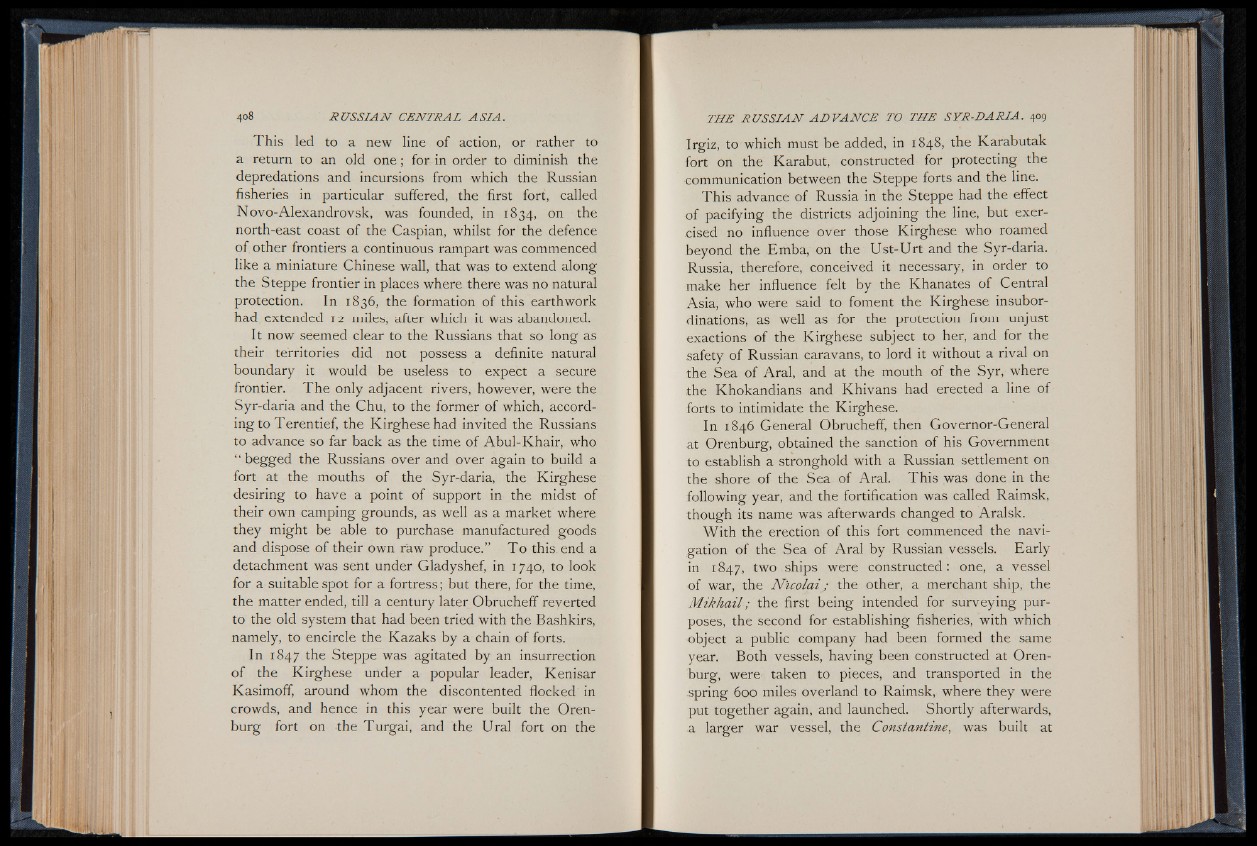
This led to a new line of action, or rather to
a return to an old o n e ; for in order to diminish the
depredations and incursions from which the Russian
fisheries in particular suffered, the first fort, called
Novo-Alexandrovsk, was founded, in 1834, on the
north-east coast of the Caspian, whilst for the defence
of other frontiers a continuous rampart was commenced
like a miniature Chinese wall, that was to extend along
the Steppe frontier in places where there was no natural
protection. In 1836, the formation of this earthwork
had extended 12 miles, after which it was abandoned.
It now seemed clear to the Russians that so long as
their territories did not possess a definite natural
boundary it would be useless to expect a secure
frontier. The only adjacent rivers, however, were the
Syr-daria and the Chu, to the former of which, according
to Terentief, the Kirghesehad invited the Russians
to advance so far back as the time of Abul-Khair, who
“ begged the Russians over and over again to build a
fort at the mouths of the Syr-daria, the Kirghese
desiring to have a point of support in the midst of
their own camping grounds, as well as a market where
they might be able to purchase manufactured goods
and dispose of their own raw produce.” T o this, end a
detachment was sent under Gladyshef, in 1740, to look
for a suitable spot for a fortress 5 but there, for the time,
the matter ended, till a century later Obrucheff reverted
to the old system that had been tried with the Bashkirs,
namely, to encircle the Kazaks by a chain of forts.
In 1847 the Steppe was agitated by an insurrection
of the Kirghese under a popular leader, Kenisar
Kasimoff, around whom the discontented flocked in
crowds, and hence in this year were built the Orenburg
fort on the Turgai, and the Ural fort on the
Irgiz, to which must be added, in 1848, the K ara-butak
fort on the Karabut, constructed for protecting the
communication between the Steppe forts and the line.
This advance of Russia in the Steppe had the effect
of pacifying the districts adjoining the line, but exercised
no influence over those Kirghese who roamed
beyond the Emba, on the Ust-Urt and the Syr-daria.
Russia, therefore, conceived it necessary, in order to
make her influence felt by the Khanates of Central
Asia, who were said to foment the Kirghese insubordinations,
as well as for the protection from unjust
exactions of the Kirghese subject to her, and for the
safety of Russian caravans, to lord it without a rival on
the Sea of Aral, and at the mouth of the Syr, where
the Khokandians and Khivans had erected a line of
forts to intimidate the Kirghese.
In 1846 General Obrucheff, then Governor-General
at Orenburg, obtained the sanction of his Government
to establish a stronghold with a Russian settlement on
the shore of the Sea of Aral. This was done in the
following year, and the fortification was called Raimsk,
though its name was afterwards changed to Aralsk.
With the erection of this fort commenced the navigation
of the Sea of Aral by Russian vessels. Early
in 1847, two ships were constructed: one, a vessel
of war, the N ico la i; the other, a merchant ship, the
M ik h a il; the first being intended for surveying purposes,
the second for establishing fisheries, with which
object a public company had been formed the same
year. Both vessels, having been constructed at Orenburg,
were taken to pieces, and transported in the
spring 600 miles overland to Raimsk, where they were
put together again, and launched. Shortly afterwards,
a larger war vessel, the Constantine, was built at